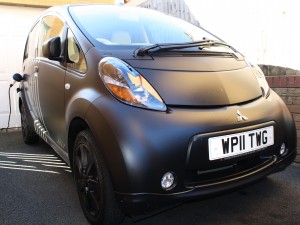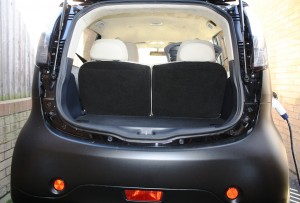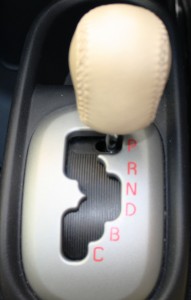Mitsubishi i-MiEV
 THIS TINY electric car terrified me. I was so stressed driving it at first – not because it was a pig to drive or anything – I was just so paranoid I’d run out of power and not find a socket to charge the little i-MiEV up.
THIS TINY electric car terrified me. I was so stressed driving it at first – not because it was a pig to drive or anything – I was just so paranoid I’d run out of power and not find a socket to charge the little i-MiEV up.
It’s fine if you live in London – the trendy heart of green transportation. There are bikes and city cars to hire and electric sockets to plug your vehicle into all over the place. Birmingham has even got a few charging points now and, I dare say, so have some other major cities. But if, like me, you live in a fairly nondescript town somewhere in Northamptonshire then your options, aside from your electricity supply at home, are fairly limited.
Take this week. I needed to drive from Kettering (oops, I’ve let the cat out of the bag) to Leicester for a meeting at a radio station. Everyone clucked over the “cool looking” i-MiEV in the car park. I couldn’t disagree – my test vehicle was cloaked in matt black with a cream leather interior. But what really unnerved me was the trip back home. I’d stuck my foot down on the 20 mile trip there, and on the return leg my right foot was pretty heavy again. I soon lifted it off the gas (I mean electricity), when I noticed the ‘fuel’ gauge, or in this case the charge gauge, was down to one bar – and then, all of a sudden, it was flashing zero. Help! At this point I decided to lift my foot off the accelerator pedal. This lets the motor operate as a power generator and the car’s motion energy is converted to electricity which charges the traction battery. This is known as’ regenerative braking’. The feeling is similar to the one you get when you engine brake going through the gears in a manual ‘normal’ car. It’s clever stuff. And it’s needed. It got me home – just!
You see, the i-MiEV has only got a maximum range of 90 miles – and that’s if you drive it like a granny. That’s the downside if you venture too far from home without checking if there are any public charging facilities en route. But the upside is that it has zero emissions, so you don’t pay any road tax and the car is London Congestion Charge exempt. It’s also very cheap to run – obviously!
Inside, the mini Mitsubishi is surprisingly spacious and the boot is not bad either. Behind the wheel, the electric car is nippy and fun. It can handle 70 mph easily on the motorways, but around town is where it feels the best. It zips from here to there with ease, and parking the i-MiEV is a piece of cake.
At first, it takes a little bit of thought about the best gear to be in. The car has a few drive positions, you see: D (for city driving); B (for going downhill) and C (for comfortable driving). B is a good mode to be if you live in undulating surroundings because it increases the Mitsubishi’s usability on hills, and gives stronger regenerative braking than the D position.
Yes, all in all, despite the initial worry of running out of power, I enjoyed my time with the i-MiEV. It looked pretty cute sat on my drive hooked up to my garage’s power socket – and, on the road, I soon got used to the eerie silence of not having an internal combustion engine under the bonnet. I can certainly say that Mitsubishi’s i-MiEV is a world away from the first electric vehicle I ever clapped eyes on – the once familiar, but now increasingly rare, milk float!
PROS ‘N’ CONS
- Environmentally friendly √
- Cheap to run √
- Nippy √
- Fun √
- Range X
FAST FACTS
- Max speed: 81 mph
- 0-62 mph: 13 secs
- Engine: Electric
- Max. power (bhp): 66 at 8000 rpm
- Max. torque (lb/ft): 133 at 2000 rpm
- CO2: 0 g/km
- Price: £ 28,990 on the road
Simply Spalding and Simply Holbeach, June 2012
-
Categories
- Abarth
- Alfa Romeo
- Aston Martin
- Audi
- Bentley
- BMW
- Caterham
- Chevrolet
- Chrysler
- Citroen
- Dacia
- DS
- Ferrari
- Fiat
- Ford
- Great Wall
- Honda
- Hyundai
- Infiniti
- Isuzu
- Jaguar
- Jeep
- Kia
- Land Rover
- Lexus
- Lotus
- Maserati
- Mazda
- McLaren
- Mercedes
- MG
- Mini
- Miscellaneous Articles
- Mitsubishi
- Morgan
- Motability
- Nissan
- Peugeot
- Porsche
- Renault
- Rolls-Royce
- Saab
- Seat
- Skoda
- Subaru
- Suzuki
- Tesla
- Toyota
- Vauxhall
- Volvo
- VW
- Zenos
-
Articles
- July 2024
- March 2024
- January 2024
- December 2023
- September 2023
- August 2023
- May 2023
- January 2023
- October 2022
- July 2022
- May 2022
- April 2022
- February 2022
- December 2021
- November 2021
- October 2021
- September 2021
- August 2021
- July 2021
- June 2021
- May 2021
- April 2021
- March 2021
- February 2021
- January 2021
- December 2020
- November 2020
- October 2020
- September 2020
- August 2020
- July 2020
- June 2020
- May 2020
- April 2020
- March 2020
- February 2020
- October 2019
- September 2019
- August 2019
- July 2019
- June 2019
- April 2019
- March 2019
- February 2019
- January 2019
- October 2018
- August 2018
- July 2018
- June 2018
- April 2018
- March 2018
- December 2017
- August 2017
- July 2017
- June 2017
- May 2017
- March 2017
- February 2017
- January 2017
- December 2016
- November 2016
- October 2016
- September 2016
- August 2016
- July 2016
- May 2016
- April 2016
- March 2016
- February 2016
- January 2016
- December 2015
- November 2015
- October 2015
- September 2015
- August 2015
- July 2015
- June 2015
- May 2015
- April 2015
- March 2015
- February 2015
- January 2015
- December 2014
- November 2014
- October 2014
- September 2014
- August 2014
- July 2014
- June 2014
- May 2014
- April 2014
- February 2014
- January 2014
- December 2013
- November 2013
- October 2013
- September 2013
- August 2013
- July 2013
- June 2013
- May 2013
- April 2013
- March 2013
- February 2013
- January 2013
- December 2012
- November 2012
- October 2012
- September 2012
- August 2012
- July 2012
- June 2012
- May 2012
- April 2012
- March 2012
- February 2012
- January 2012
- December 2011
- November 2011
- October 2011
- September 2011
- August 2011
-
Meta






